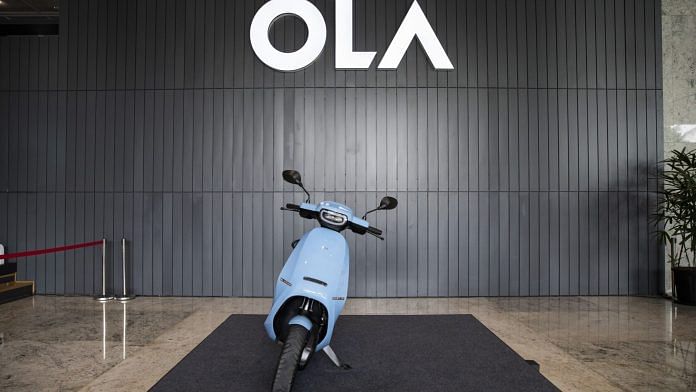Bengaluru: Ola Electric Mobility Pvt priced its electric scooter at 99,999 rupees ($1,348) in an attempt to crack the affordability barrier for electric two-wheelers in value-conscious India.
The SoftBank Group Corp.- and Tiger Global Management-backed electric vehicle unicorn unveiled the price of the Ola S1 during an official launch timed to coincide with India’s Independence Day on Sunday. The basic version of the electric scooter will have a range of 121 kilometers (75 miles) on a complete charge.
The final price will vary according to subsidies offered by each state government, the company said. Deliveries will commence in October in over 1,000 cities, and exports to countries in Asia, Latin America and Europe will begin in the coming months.
“By 2025, all two-wheelers sold in India should be electric, that’s my mission,” said Bhavish Aggarwal, chairman and group chief executive officer of Ola Group, which also includes the Ola ride-hailing service. The plan is to begin an initial production run of one million scooters in coming months, which will be ramped up as demand builds, he said.
“We want 50% of all electric two-wheelers produced for the world to be made in India,” Aggarwal said at a media conference ahead of the public unveiling of the scooter. “The ambition is to make India a global EV leader.”
Aggarwal’s global electric vehicle ambitions hinge on the make-or-break pricing for the bike. Affordability could help achieve scale in the home market where rival petrol-fueled scooters cost around $1,000. Low running costs per kilometer and inexpensive maintenance could help it take traditional two-wheeler makers head on.
When the scooter opened for pre-bookings a few weeks ago, the company received over 100,000 orders within 24 hours. It charged a booking charge of 499 rupees, and has lined up nine banks to facilitate purchases on monthly payments of 2,999 rupees.
India is the world’s largest two-wheeler market — scooters and motorcycles clog roads and add to pollution in its densely-populated cities. Electric vehicle sales are low but have been climbing steadily as the government pushes for its adoption through subsidies. India’s electric vehicle market could be worth nearly $206 billion in a decade with over 100 million units sold — about 200 times the current number, according to think tank CEEW Centre for Energy Finance.
The country is the third-largest carbon-emitter after China and the U.S. and petrol prices are at an all-time high. Ola’s founder wagers that the country’s ambitious electric vehicle goals make it a market ripe for disruption.
“Traditional automakers are still selling lemons to buyers,” Aggarwal said. “It’s time to give India’s young population what they want.” Ola has yet to spend money on traditional marketing, and is instead mainly relying on social media posts, he said.
There are headwinds for Ola and its electric vehicle rivals.
“If India is to entirely rely on the improving economics of electric vehicles for long-term adoption, it could miss its 2030 EV adoption goal by a wide margin,” said Tom Allen Abraham, an advanced mobility and storage analyst with BloombergNEF. “An increase in the availability of affordable electric options, stronger government interventions like large-scale vehicle procurement tenders, tighter fuel economy regulations or the launch of a zero emission vehicle credit system can drive EV adoption in India faster than in our outlook.”
Ola’s scooter comes with a home-charging kit and the startup said it will lead the installation of the country’s largest network of charging stations dotting 100 cities. The scooter was fully engineered in Bangalore with technology ranging from keyless access and a reverse mode to help maneuver into tiny parking spaces. Its competitors include Hero MotoCorp-backed Ather Energy Pvt., whose electric scooter has been in the market for a couple of years.
Ola is building a $330 million plant in India that will have a production capacity of 10 million vehicles annually, or 15% of the world’s e-scooters by the end of 2022. The 2 million square feet factory will have the capacity to roll out one scooter every two seconds. For now, only one of its 10 lines is operational.
Aggarwal’s goal is to design and build an array of vehicles including electric cars, all made with 90% of locally-sourced components to help boost Prime Minister Narendra Modi’s Make in India initiative and sustainable mobility ambitions. Aggarwal said work on the electric car has already started.
Chip shortages are a challenge for the production of the two-wheeler and Aggarwal said Ola is “trying to manage the live situation.” The startup is well-capitalized for now but the founder said it would raise capital needed for expansion.
Ola Electric is Aggarwal’s second turn as an entrepreneur. A decade ago, he pioneered ride-hailing in the country and took on Uber Technologies Inc. while expanding across 200 Indian cities, before heading to places such as the U.K, Australia and New Zealand. The ride-hailing company is expected to debut in public markets in 2021.
His electric vehicle startup was incorporated in 2017 and became a billion-dollar company, or unicorn, two years later, when SoftBank and Tiger invested hundreds of millions.
—With assistance from Suvashree Ghosh. — Bloomberg
Also read: Electric scooters are becoming a rage and Bengaluru’s Ather has quietly raced ahead



